|
History of
Rotary in Italy - The early years
Part of our section on the
History of Rotary in Europe |
|
|
|
|
THE BIRTH OF ROTARY IN ITALY (years from
1923 to 1930)
The Rotary movement in Italy began in Milan, in June
1923, when Mr. James Henderson and Mr. Leo Culleton, two
prominent British business men who had resided for years in this
country, gathered a small group of Italian business men to form
the nucleus of a Rotary Club.
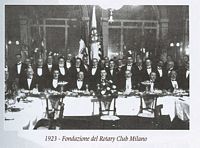 To the first group, which already included some
of the most
noted men in the city, other good elements were gradually added.
Regular weekly meetings were held and proper organization
secured, so that on December 20th, 1923, with the intervention
of special Commissioner F. W. Teele, the
Rotary Club of Milan
was formally inaugurated, thus adding Italy's name to the
already long list of countries where Rotary existed. To the first group, which already included some
of the most
noted men in the city, other good elements were gradually added.
Regular weekly meetings were held and proper organization
secured, so that on December 20th, 1923, with the intervention
of special Commissioner F. W. Teele, the
Rotary Club of Milan
was formally inaugurated, thus adding Italy's name to the
already long list of countries where Rotary existed.
Milan was most fitted to understand Rotary and to bring its
message to the Nation. Its leading position in the financial,
industrial and commercial life of the country, its frequents
contacts with business circles abroad, the presence of a large
and influential class of progressive and public spirited
business men, made of this city the ideal ground for Rotary
experience.
Very soon the meetings of the Milan Club were the object of
interest and attention on the part of the press; the addresses
given to the Club by some of the nation's leading business men
were amply quoted, and a general interest was aroused in the
country for Rotary and for its programs. As an outcome of this
interest, small organizing groups were soon formed in other
important cities, an in a few months were ready to be officially
inaugurated. If 1923 had seen the inauguration of the one Club
of Milan, 1924 brought with it the inauguration of sever other
Clubs: Trieste, Genoa, Rome, Naples, Palermo and Venice. The
largest cities in Italy were thus given the privilege of having
a Rotary Club and the prominence of the men who accepted to
preside these new Clubs and the high standard of membership soon
secured Rotary a very high prestige in public opinion.
Also in 1924 the Rotary Club of Italy started the publication
of their monthly magazine: "Il Rotary".
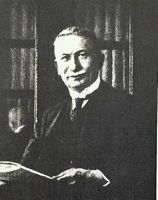 The following year, 1925, was a decisive one in the history of
Rotary in Italy. Not only the number of the Clubs was
substantially increased with the official inauguration of the
Clubs of Florence, Leghorn, Bergamo, Parma and Cuneo, but also
the Italian clubs were finally grouped in the new 46th. District,
Mr. J. Henderson being elected to the office of Governor. The following year, 1925, was a decisive one in the history of
Rotary in Italy. Not only the number of the Clubs was
substantially increased with the official inauguration of the
Clubs of Florence, Leghorn, Bergamo, Parma and Cuneo, but also
the Italian clubs were finally grouped in the new 46th. District,
Mr. J. Henderson being elected to the office of Governor.
The benefits arising from the creation of a District were
increased by the official recognition on the part of the Board
of Directors of Rotary International of the
Italian National
Council, whose composition, functions and privileges were
clearly defined and which became, with District Governor, the
leading force of the Rotary movement in Italy.
The District Treasurer was Federico Guasti,
from year 1926 until year 1938.
Another important step was taken by the
National Council in organizing a permanent District Office in
Milan, and in electing a Secretary General to assist the
Governor in his work and also to coordinate the activities of
the Clubs. Rotarian Achille
Bossi of Milan, was elected to this office.
President Everett Hill and Chesley Perry were given a vivid
evidence of the progress accomplished, when they attend the
first District Governor of the Italian Clubs held in Milan in
April 1925.
A large number of delegates from the 10 Clubs already
inaugurated and from the others then in course of organization
took part in the Conference, which lasted two days and left a
deep impression on all who attended it. This conference elected
to the office of Governor for 1925-1926 Rotarian
Giorgio Mylius
whose able and active governorship was to give a further impulse
to extension work.
In November 1925 the Italian Clubs took
part with a large
delegation in the Meeting of the Executives of European
Continental Clubs which was held in Bruxelles. Among those who
attended, we may mention, besides Giorgio Mylius and Achille
Bossi, Felice Seghezza and Prince Piero Ginori Conti who later
were to became Governors of the 46th District.
The following year was largely devoted to the proper
organization of the existing clubs. Only two new clubs were
inaugurated: those of Cremona and Piacenza; but the number of
Rotarians steadily increased, and the frequent intercourse
between the members of various clubs contributed materially to
develop that spirit of national fellowship which is a typical
feature of Rotary in Italy.
The District Conference of 1926 was again held in Milan on April
21, 22, 23 and by its success far surpassed the previous one.
President Donald Adams and Past President Crawford Mac Cullough
were present, and had an opportunity to address a large number
of Rotarians who had come to Milan from all parts of Italy.
Piero Pirelli was elected by this Conference to succeed Giorgio Mylius, who closed his year
of splendid work for Rotary as
Governor, representing the 46th District at the Denver
Convention.
|
|
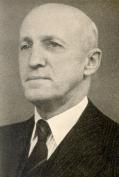 In July 1926 the Board
of Directors of Rotary International
showed their appreciation of Italy's contribution to Rotary by
electing Rotarian Felice Seghezza of Genoa, to the office of
Director. In July 1926 the Board
of Directors of Rotary International
showed their appreciation of Italy's contribution to Rotary by
electing Rotarian Felice Seghezza of Genoa, to the office of
Director.
Piero Pirelli's governorship marked a year of important
achievements. His character and broad experience of affairs exceptionally
qualified him for the high office of Governor, and his ability
in direction the activities of the District, together with his
untiring diligence and unfailing courtesy, won for him the
appreciation and affection of all the members and contributed in
a large degree to consolidate the position of Rotary throughout
the country.
Four clubs were inaugurated during Pirelli's governorship: the
Club of Piacenza, already mentioned, and the Clubs of Bologna,
Brescia and Como.
|
|
 On January 1st 1927 the District begun to
publish besides the magazine "Il Rotary" above referred to and
whose circulation is limited to Rotarians, another monthly review: "RealtÓ" containing the best addresses given in the clubs and intended
for the public at large. On January 1st 1927 the District begun to
publish besides the magazine "Il Rotary" above referred to and
whose circulation is limited to Rotarians, another monthly review: "RealtÓ" containing the best addresses given in the clubs and intended
for the public at large.In February 1927 the District adopted the
official Italian
translation of the Constitution of the Rotary Club approved by
the board of R.I. and the National Council approved a standard
text of the Club's By Laws, which was uniformly adopted by all
the Rotary Clubs of Italy.
At the same time other events came to show how Rotary stood in
the country. H.R.H. the Duke of Aosta honoured Rotary by
accepting the honorary membership of the R.C. of Naples, and at
the banquet offered him by his Club made a notable speech
showing his appreciation of Rotary and of its contribution to
the progress of the nation. A few months later the two brothers
of the Duke entered Rotary, the Duke of the Abruzzi becoming an
honorary member of the R.C. Genoa, and the Count of Turin an
honorary member of the R.C. of Florence.
In April 1927 the Crown Prince Umberto
of Savoia most
graciously accepted the nomination as Honorary Member of the
R.C. of Cuneo, the little city at the foot of the Alps in whose
district he was born, and which for centuries was one of the
strongest bulwarks of the dynasty of Savoy.
The District Conference for 1927 was held in Leghorn (Livorno),
in the early days of May, and the importance of its work and the
large attendance proved how great a progress Rotary had made
during the year.
It was a privilege for European Rotarians to have the
1927
Rotary Convention in Ostend. The Italian Clubs took full
advantage of this opportunity. They were all represented, and the
Italian delegation amounted to 61 members.
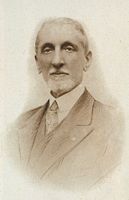 Director Seghezza had no sooner returned from an extensive trip
visiting Rotary Clubs in America, when he was informed of
his election to the office of Governor of the 46th District for
1927-1928. After having presided for two years the R.C. of
Genoa, and after one year intensive work as Director, Seghezza
was surely entitled to some rest, and only his deep sense of
duty could induce him to accept the nomination. Director Seghezza had no sooner returned from an extensive trip
visiting Rotary Clubs in America, when he was informed of
his election to the office of Governor of the 46th District for
1927-1928. After having presided for two years the R.C. of
Genoa, and after one year intensive work as Director, Seghezza
was surely entitled to some rest, and only his deep sense of
duty could induce him to accept the nomination.
On September 6th 1927 the Crown Prince was
officially received at the R.C. of Cuneo, Governor Seghezza and
Immediate Past Governor Pirelli being present together with the
Presidents of all the Italian Clubs. A few days later, on
September 19th the Executives Meeting of the Italian District
was held in Como, under the presidency of President Sapp and
with the intervention of Chesley Perry and Past President Frank
Mulholland. The luncheon was honored by the presence of the
Crown Prince who spent most of the time in lively conversation
with President Sapp.
After the Como meeting, President Sapp and Chesley Perry went to
Milan and then to Rome, where, together with Governor Seghezza,
they were received in private audience by Mr. Mussolini. The official communication issued to the press by the Premier's
Press Bureau contained the following interesting statement:
"The Head of the Government very much appreciated the greetings
addressed to him, and showing himself well acquainted with the
object Rotary pursues by creating friendly intercourse and
cooperation between the most prominent representatives of the
various business and intellectual activities of the world,
expressed his cordial satisfaction, reciprocating with his
sentiments of good will".
On New Year's day 1928, Governator
Seghezza announced in his message to the Italian Clubs that H.M.
the King had deigned to accept honorary membership of the Club
of Rome and to become Honorary Governor of the Italian District.
This had been the greatest desire of Italian Rotarians, and the
event was celebrated with enthusiastic manifestations in all of
the Clubs.
The strong personality of the King, and his prominent influence
in the history and progress of Italy are so well known that we
hardly need to point out the value of such an high recognition.
Few men in this time embody the Rotary ideals as Victor Emmanuel
the Third.
On January 17th 1928 the King received in private audience
Governor Felice Seghezza, Achille Bossi (Secretary General) and
the officers of the Rome Rotary Club who expressed to H.M. the
gratitude and appreciation of all Rotarians.
Extension work was actively resumed in the early months of the
year. The Club of Messina was officially inaugurated, and the
organization of other Clubs properly started.
The fourth District's Conference was held in Turin in May, and
by its success far surpassed all the former ones.
The Conference was inaugurated by H.R.H. the Crown Prince at the
presence of H.R.H. the Prince of Udine (also a Rotarian) and of
all the civil and military authorities. The Prince was visibly
pleased with the words of greetings addressed to him by Governor
Seghezza and by Stanley Leverton on behalf of Rotary
International, and followed with great interest an address given
by a prominent writer, Rotarian Ugo Ojetti, on "Art, Science and
Rotary".
The second meeting was presided by the Duke of Aosta. Some of
Italy's leading men in business, literature and arts addressed
the Conference, both on subjects of national interest and on
subject strictly relating to Rotary, and the press gave very
diffused accounts of the proceedings.
In June 1928 the Italian clubs attended the
Minneapolis
Convention with a delegation of 26 members. The
Rotary Club of Brescia, with three delegates, won the Attendance Trophy.
Brescia, with three delegates, won the Attendance Trophy.
The Turin Conference elected as Governor Prince Piero Ginori
Conti, Senator of the Kingdom and former President of the Rotary
Club of Florence, who took possession of his office on July 1st
1928.
|
|
|
During
his term three new Clubs were inaugurated: Varese, Verona and
Novara; the organization of the District was improved and the
position of Rotary in the country was consolidated. The fifth District Conference was held in Naples on May 9th,
10th and 11th 1929, with a splendid attendance from all Clubs,
in an atmosphere of increased fellowship.
Rotarian Achard represented Rotary International, while the
Italian Government was represented by Rotarian M. Castelli, High
Commissioner for the Province of Naples. The Conference
discussed several matters of strictly Rotarian character, and a
group of competent speakers dealt with the demographic problem,
which is one of the subjects
on which public opinion is most interested in Italy. But
the most important action of the Conference was the voting of a
resolution intended to state the position of Rotary with
reference to a Rotarian's relation to his country. The
resolution was shortly afterwards submitted by the Italian clubs
to the
Convention of Dallas, where it was finally adopted. As
this resolution clearly reflects the attitude of the Italian
Rotarians on some fundamental aspects of Rotary. Here's its
text:
|
|
"Through cooperation and
fellowship between the representatives of the various business
and professional lines Rotary affirms the duty of every citizen
to address his first of all towards the progress and prosperity
of his country.
Rotary has no political or religious character and as such it
never intended nor intends to form any party or any sect nor to
adopt a particular moral code. As men of different religions may
belong to it, Rotary has absolute respect for the religious
faith of its members. Organized in fifty-two countries, Rotary
in each of them conforms its action to sincere respect and
regards for the political and religious institutions of the
Nation and expects its members, while cooperating toward a
cordial international understanding, to be thoroughly loyal to
their religious and moral ideals and to the higher interests of
their particular country".
|
|
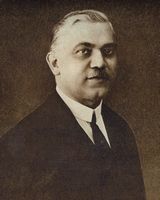 The Naples Conference elected the office of Governor, for
1929-1930, Rotarian Biagio Borriello, charter member and
President of the R.C. of Naples, member of the Parliament,
president of the Chamber of Commerce of Naples, a prominent man
in the shipping business both in Italy and abroad.
THE ITALIAN NATIONAL COUNCIL
The Board of Directors of Rotary International,
approved in 1925 the creation of a National Council, to assist
the Governor of the 46th District in the administration of
Rotary in Italy. The Council was composed of delegates from the
various Clubs of the District, each Club having the right to
appoint one delegate for every 25 members or major fraction.
The Council is essentially a consultative body, and its
resolutions may be carried out only through the Governor and
with the consent of the Governor who can also veto any
resolution not consistent with the Constitution and By Laws of
Rotary International.
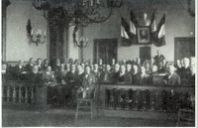 The
National Council has proved very useful in creating frequent and
close contacts between the leading men of the different Clubs,
in unifying ideas and pratical policies, in enabling the
Governor to keep in touch with the tendencies and opinions of
the various Clubs of Italy into a definite body with a national
field of action and a national character. The
National Council has proved very useful in creating frequent and
close contacts between the leading men of the different Clubs,
in unifying ideas and pratical policies, in enabling the
Governor to keep in touch with the tendencies and opinions of
the various Clubs of Italy into a definite body with a national
field of action and a national character.
The Council met three time every year: in spring, fall and
winter and its members were elected every year by the various
Clubs. The General Secretary , the Assistant General Secretary
and the Treasurer of the District (it was 46th), were elected
every year by the National Council its self. The picture
represent a meeting of the National Council in 1927, Park Hotel
in Leghorn.
CHRONOLOGY OF THE BIRTH OF ROTARY CLUBS IN ITALY, UNTIL
YEAR 1950 (48 Clubs)
20 December 1923:
Rotary Club Milano
24 March 1924:
Rotary Club Trieste
6 January 1925:
Rotary Club Roma, Napoli and Torino
7 January 1925:
Rotary Club Palermo
31 January 1925:
Rotary Club Genova
7 March 1925:
Rotary Club Firenze
8 March 1925:
Rotary Club Livorno (Leghorn)
16 March 1925:
Rotary Club Venezia
13 June 1925:
Rotary Club Bergamo
3 October 1925:
Rotary Club Parma
18 October 1925:
Rotary Club Cuneo
1926: Rotary
Club Cremona and Piacenza
1927: Rotary
Club Bologna, Brescia and Como
1928: Rotary
Club Verona and Messina
1929: Rotary
Club Varese and Novara
1930: Rotary
Club Catania and La Spezia
1931: Rotary
Club Savona
1932: Rotary
Club Sanremo
1933: Rotary
Club Bari
1934: Rotary
Club Vicenza
1936: Rotary
Club Perugia
1937: Rotary
Club Biella
1938: Rotary
Club Alessandria
1948: Rotary
Club Ravenna and Reggio Calabria
1949: Rotary
Club Modena, Reggio Emilia, Trento, Treviso, Cagliari,
Sassari, L'Aquila, Cosenza and Siracusa 1950:
Rotary Club Bolzano, Potenza, Taranto, Crema, Pavia
and Asti
PICTURES OF THE
FIRST 3 GOVERNORS OF THE ITALIAN DISTRICT 46
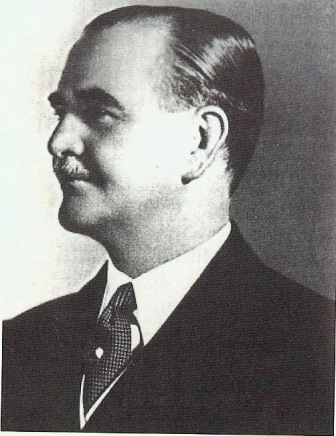 |
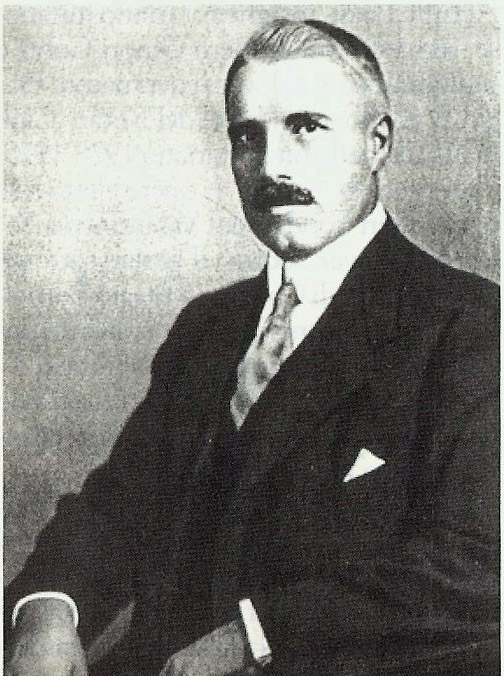 |
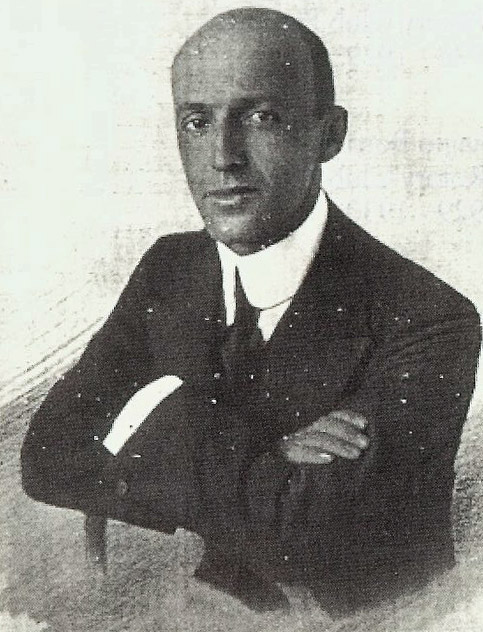 |
| James
Henderson |
Giorgio Mylius |
Piero
Pirelli |
Click on the below image to view full screen
Constitution Chart of the Leghorn Club, early March 1925.
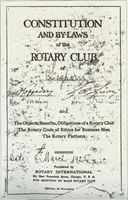
The below image is a picture of a rare
inscription, anticipating Rotarian
principles, which was sculpted in the XVth Century over the
Renaissance doorway of the noble Berardetti house, 29 - via del
Duomo, Spoleto (Italy). Click on the image to fully enlarge it.
The motto over the door, enact in ancient Italian: "Per Servire
s'acquista - Servi quando p(u)oi" which means: "Who Serves
Profits - Serve when you can".
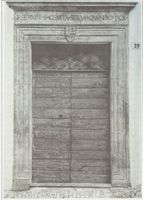 |
|
|
Provided and posted by
Pietro Brunoldi - 19
September
2008 |
|
|
|
|
|

